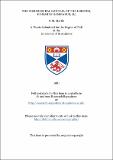The commissural ganglia of the lobster, homarus gammarus, (L)
Abstract
The bilaterally paired commissural ganglia of the lobster, Homarus gammarus, form part of the stomatogastric nervous system. The functional organization of these ganglia has been investigated using a variety of anatomical and physiological techniques. There are no consistent differences between right and left commissural ganglia. Each contains the somata of several hundred interneurons and about sixty motorneurons which supply the labrum and oesophagus. There are many input and output pathways to and from the commissural ganglia, including a large number of sensory fibres. There appears to be much interaction between these ganglia and the central and stomatogastric nervous systems. A comparison of the vitro preparation and previous studies of the semi-intact animal have shown that the isolated commissural ganglion contains at least the minimal pattern generator for oesophageal peristalsis. The isolated ganglion can also produce other rhythms, including a putative labral rhythm. The small size of most commissural ganglion neurons precludes intracellular recording and dye injection. Most "recordable" somata are silent. The activity of several neurons, including labral motorneurons, is closely related to the oesophageal rhythm. At least one neuron exhibits rhythmic activity unrelated to the oesophageal cycle. Other neurons show a tonic firing pattern; their possible functions are discussed. A large dopamine-containing neuron sends a corollary discharge of foregut activity to at least the brain. The structure and function of this neuron is discussed in detail. This study suggests that the commissural ganglia have the integratory potential to act as coordination centres for the foregut. The findings are considered in the context of the operation of the stomatogastric nervous system and suggestions are made for further research.
Type
Thesis, PhD Doctor of Philosophy
Collections
Items in the St Andrews Research Repository are protected by copyright, with all rights reserved, unless otherwise indicated.

